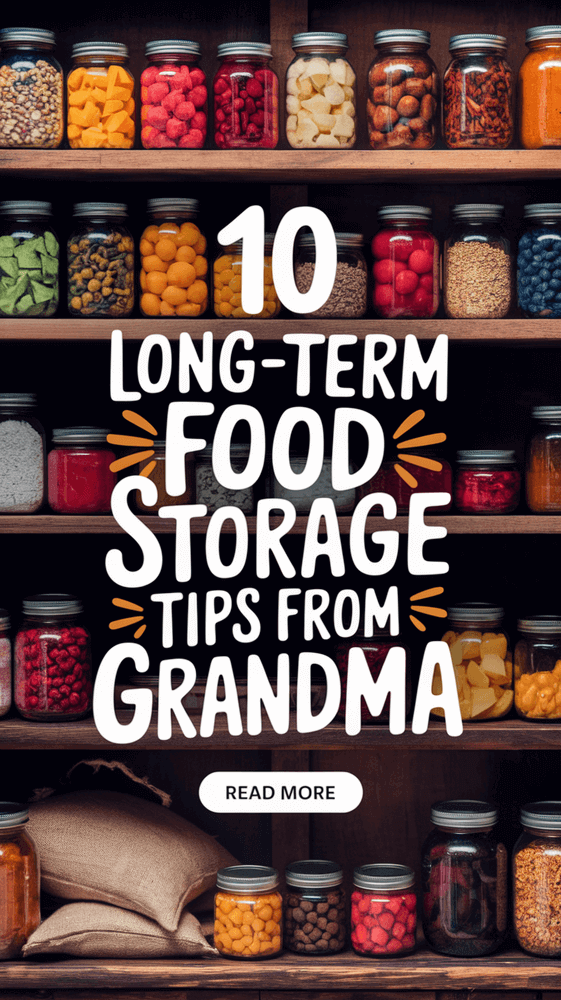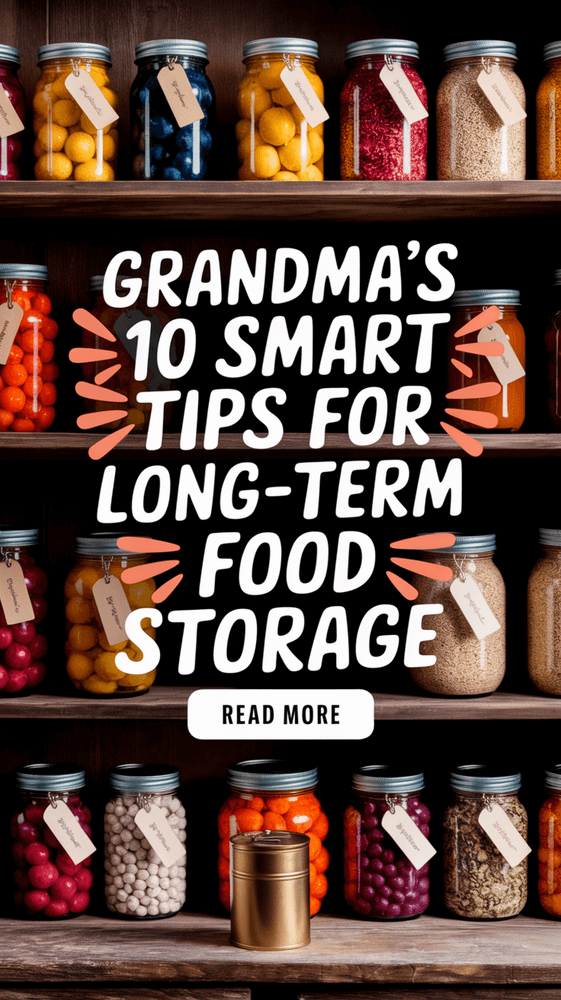I was finally tackling that deep clean I’d been putting off for months (we all have those projects, right?), and I found this can of black beans shoved way in the back behind some pasta. The expiration date? March 2019.
My first thought was embarrassment, but then I got hit with this wave of missing my grandma so hard it nearly knocked me over. Because see, this never would have happened in her house. Never. That woman could tell you exactly what was in every corner of her pantry, when she bought it, and probably what she planned to make with it next Tuesday.
I remember being maybe eight years old, sitting on her kitchen counter while she made dinner, watching her pull ingredients from what seemed like thin air. “Grandma, how do you always have everything?” I’d ask, swinging my legs and probably getting in her way. She’d just smile and say something like, “Baby, you take care of what takes care of you.” At the time, I thought she was just talking about food. Now I realize she was talking about so much more.
Growing up, I took it for granted that her pantry was this treasure trove of perfectly organized abundance. Rows of mason jars filled with colorful preserves, bins of grains that somehow never went stale, canned goods arranged like soldiers ready for battle. Her basement storage room looked like a small grocery store, but everything had its place and purpose. When Hurricane Sandy hit our area years ago and everyone was scrambling for supplies, my grandma just shrugged and started pulling things from her “extras” like it was no big deal.
She passed away five years ago, and I inherited a few of her storage containers along with a handwritten notebook full of her preservation tips. I’d been meaning to really dive into that notebook, but life kept getting in the way. Then 2020 happened. Then supply chain issues. Then inflation making grocery trips feel like major financial decisions. Suddenly, that notebook started feeling less like a relic and more like a roadmap.
The thing is, my grandma wasn’t a prepper in the modern sense. She wasn’t worried about zombies or societal collapse. She just grew up during the Depression, lived through rationing during World War II, and understood something we seem to have forgotten: food security isn’t just about having enough to eat today. It’s about having enough peace of mind to sleep well at night.
What gets me excited about sharing this with you is that her methods weren’t complicated or expensive. She wasn’t buying fancy freeze-dried meals or investing in underground bunkers. She was just smart, organized, and incredibly intentional about how she approached feeding her family. And honestly? Her system worked better than most of the modern solutions I’ve tried.
I’ve been implementing her techniques for the past couple of years, adding some modern updates that I think would make her proud. My pantry finally feels like something she’d approve of, and more importantly, I feel prepared in a way that doesn’t make me anxious. There’s something deeply comforting about opening your cabinet and knowing you could feed your family well for weeks without a single grocery run.
So let’s dive into the wisdom she left behind, mixed with some contemporary tricks that complement her time-tested methods. Because whether we’re dealing with natural disasters, economic uncertainty, or just wanting to reduce those stressful “what’s for dinner” moments, having a solid food storage system is one of the most loving things you can do for yourself and your people.
The Foundation: Getting Your Storage Game Right
Here’s where my grandma would start muttering in her native language if she saw how most of us store food. The first rule she lived by was simple: if your storage area isn’t clean, nothing else matters. I learned this the hard way when I found mouse droppings in a bag of flour I’d left in a cardboard box. Lesson learned, and let me tell you, I scrubbed that entire pantry like I was preparing for surgery.
Start by clearing out everything that’s past its prime. Those crackers that sound like sand when you shake the box? Gone. The spices you bought for one recipe two years ago and never touched again? Time to say goodbye. That flour you swear you’ll use for homemade bread someday? If it smells even slightly off, toss it. My grandma used to say, “Better safe than sorry, and sorry doesn’t feed the family.”
Once everything questionable is out, clean every surface. Wipe down shelves, vacuum corners, check for any signs of pests. I use a mixture of white vinegar and water because it’s effective and won’t leave residue that might affect food later. This isn’t just about looking neat: it’s about creating an environment where your stored food can actually last as long as it’s supposed to.
- Before you hit “buy” on your next decor order, there’s a free 10-second step you should never skip: checking Rakuten (Ebates). I simply find the store name, click the deal, and shop like normal, and Rakuten sends me real cashback! Prices keep climbing everywhere, but this is one way to get a little back on the things you were going to purchase anyway. New members even get a $30 bonus when they spend $30 — which means your first order could pay you back instantly. Don’t miss out again. Click here to sign up and save money!
*Disclosure: This post includes affiliate links. I may earn a small commission if you join Rakuten through my link — but it doesn’t cost you anything extra. In fact, you’ll actually save more!
Now for location. My grandma’s storage areas always felt cool and comfortable, even in summer. She chose spots that stayed between 50-70°F consistently, away from heat sources and windows. Heat makes everything spoil faster, light breaks down nutrients and changes flavors, moisture invites mold and bacteria, and we all know what pests can do to a perfectly good supply of rice.
I learned about containers the expensive way. My first attempt at bulk storage involved those big plastic bags you get rice in, and within six months, I had weevils. My grandma would have shaken her head at me. She always transferred everything into glass jars, metal tins, or thick plastic containers with tight-fitting lids. “If air can get in, everything else can too,” she’d say, tapping the lid of whatever she was sealing up.
The investment in good containers pays for itself quickly when you’re not throwing away spoiled food every few months. I’ve started collecting mason jars from yard sales and thrift stores, and I swear some of the vintage ones seal better than new ones.
The FIFO Method: Grandma’s Secret to Never Wasting Food
My grandma had this habit that seemed almost obsessive at the time. Whenever she brought home groceries, she’d move older items to the front and put new ones in the back. I used to think she was being unnecessarily fussy, but now I realize she was implementing first in, first out like a professional chef.
This system means you’re always using the oldest items first, so nothing gets forgotten and goes bad. I started doing this religiously after finding that 2019 can of beans, and the difference is incredible. No more mystery dates, no more “is this still good?” sniff tests, no more guilt about wasting food.
The trick is being consistent. Every time you shop, new items go behind older ones. It takes an extra few minutes, but it saves hours of cleaning out expired food later. My mom used to complain about how long grocery shopping took with my grandma, but now I understand she wasn’t just shopping, she was maintaining a system.
I’ve adapted this for my smaller space by using clear storage bins that slide in and out of my pantry shelves. New stuff goes in the back of each bin, older items migrate forward naturally. It’s like having a tiny conveyor belt system in your kitchen.
Oxygen Absorbers: The Modern Upgrade Grandma Would Love
This is where we get to blend grandma’s wisdom with some contemporary food science, and honestly, I think she would have been fascinated by this technology. Oxygen absorbers are these small packets that remove oxygen from sealed containers, basically putting your food into suspended animation.
My grandma preserved food through canning, dehydrating, and root cellaring, but she couldn’t have imagined being able to store dry goods for decades with these little packets. They work incredible well for grains, beans, pasta, flour, anything dry that you want to keep for the long haul.
Here’s what I wish someone had told me when I started: make sure your food is really dry before sealing it with oxygen absorbers. If there’s too much moisture (anything over 10% and you can get a cheap moisture meter to check), removing the oxygen creates perfect conditions for botulism to grow. Not the kind of science experiment anyone wants in their food storage.
I use them in Mylar bags inside food-grade buckets for my bulk grains and beans. The Mylar provides an extra barrier against light and moisture, while the bucket keeps everything pest-proof and easy to stack. Label everything clearly with contents and the date you sealed it. Trust me, six months later you won’t remember if that bucket contains white rice or quinoa.
Creative Storage Spaces That Would Make Grandma Smile
My grandma was the queen of finding storage space where others saw empty air. She had this way of looking at a room and seeing possibilities everywhere. That space above your kitchen cabinets that collects dust? She would have lined it with canned goods. Those deep dining room hutches that most people use for dishes they never touch? Perfect for emergency supplies.
I learned this lesson when I was helping my aunt clean out grandma’s house after she passed. We found food stashed in the most unexpected places: a case of soup above the refrigerator, jars of home-canned green beans behind the good china, bags of rice in the coat closet. At first it seemed random, but then I realized there was method to it. She was distributing weight, controlling temperature, and keeping different categories of supplies in logical locations.
One thing that always amazed me was how she displayed her home-canned foods like artwork. Those rows of jewel-toned preserves on open shelving weren’t just storage, they were a celebration of her hard work. Walking into her kitchen felt like entering a museum of abundance. I’ve started doing something similar with store-bought canned goods, arranging them by color and size on visible shelves. It makes my kitchen feel more intentional and reminds me daily of what I have available.
But my favorite discovery was her “treasure stashes.” Hidden throughout her bulk storage containers, she’d tucked away special treats, small gifts for future holidays, even love notes for family members. I found a tin of her favorite peppermints in a bucket of wheat, wrapped with a note that said, “For when the world feels too serious.” Finding things like that months after she was gone felt like getting hugs from beyond.
I’ve adopted this practice too. In my emergency food supplies, I hide playing cards, puzzle books, packets of hot cocoa mix, even some good chocolate. Because if we’re ever stuck depending on our food storage, we shouldn’t have to be miserable while we’re at it.
The Stories Behind the System
What I understand now that I didn’t as a kid is that my grandma’s food storage was never just about the food. It was about love, security, and taking care of her people in ways they might not even realize they needed.
She grew up during the Great Depression, when families really did depend on what they could grow, preserve, and store to survive the winter. Her mother taught her that a well-stocked pantry was insurance against uncertainty, and she carried that lesson forward even when times got easier. But she also understood that people need more than just calories to thrive.
Alongside the practical stuff like flour and canned vegetables, she stored soap, candles, first aid supplies, even fabric and thread for repairs. Her storage areas held everything a family might need during tough times: physical necessities, but also comfort items and things to keep people occupied and hopeful.
She taught me that preparation isn’t about expecting the worst, it’s about being ready to take care of yourself and your community no matter what happens. Whether it’s a natural disaster, economic hardship, or just an unexpectedly busy week where grocery shopping doesn’t happen, having supplies on hand reduces stress and increases options.
Her notebooks, which I finally read cover to cover last year, are filled with more than just preservation techniques. There are lists of what to stock for different family sizes, rotation schedules to keep everything fresh, even suggestions for meals that use only shelf-stable ingredients. But scattered throughout are little notes about adding beauty to storage areas, hiding surprises for grandchildren to find, and ways to make emergency preparedness feel less scary and more empowering.
Making It Work for Your Real Life
I’m not suggesting you need to transform your entire house into a mini grocery store (though after the past few years, would that really be so terrible?). The beauty of my grandma’s approach was that it scaled to fit your space, budget, and family size.
Start with what you already have. Organize it, clean it up, and make sure you’re using the oldest items first. Invest in some good containers gradually, ones that will last and really protect your investment in food. Pick one unexpected storage spot and make it work for you.
The confidence that comes from opening your pantry and seeing everything organized, labeled, and ready is something special. When friends notice your setup and start asking questions, you’ll realize you’ve become the go-to person for advice about food storage. And honestly? There are worse reputations to have.
What moves me most about carrying on my grandma’s traditions is that it connects me to her every time I open a jar or rotate my supplies. She’s been gone for years, but her wisdom still feeds my family. Her love still protects us. Her foresight still gives us peace of mind.
At the end of the day, building a food storage system isn’t about fear or expecting disaster. It’s about loving your people enough to make sure they’re taken care of, no matter what life throws at you. It’s about carrying forward the kind of practical wisdom that kept families strong for generations. And maybe, if we’re lucky, it’s about creating something beautiful and meaningful that we can pass down to the next generation, along with all the stories and love that make it matter.
- Before buying anything online, check Rakuten (formerly Ebates) — either with the browser extension or directly on Rakuten.com. Just type in your store, click the current deal, and shop as usual. Every purchase earns you cashback that can be mailed to you or sent via PayPal. In today’s economy, even a few dollars back can turn into a Starbucks latte, McDonald’s fries for the kids, or a little treat you don’t have to budget for. If you’ve never used Rakuten before, you’re missing out on free money — and right now, you’ll even get a $30 bonus when you spend your first $30. Click here to sign up and stop letting your online orders steal from you. Click here to sign up and save money!
*Disclosure: This post includes affiliate links. I may earn a small commission if you join Rakuten through my link — but it doesn’t cost you anything extra. In fact, you’ll actually save more!



